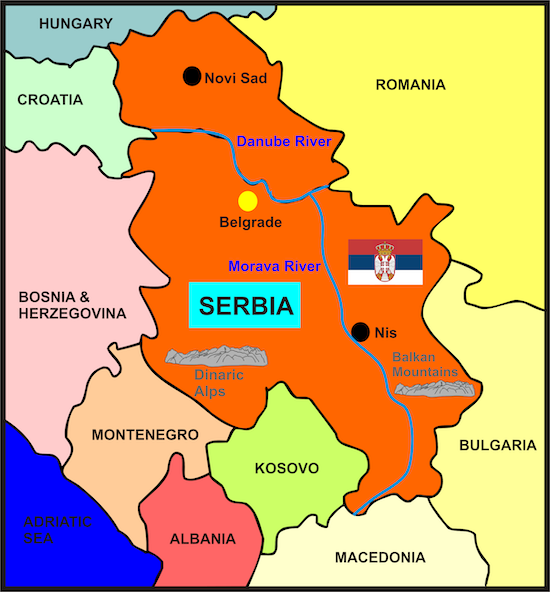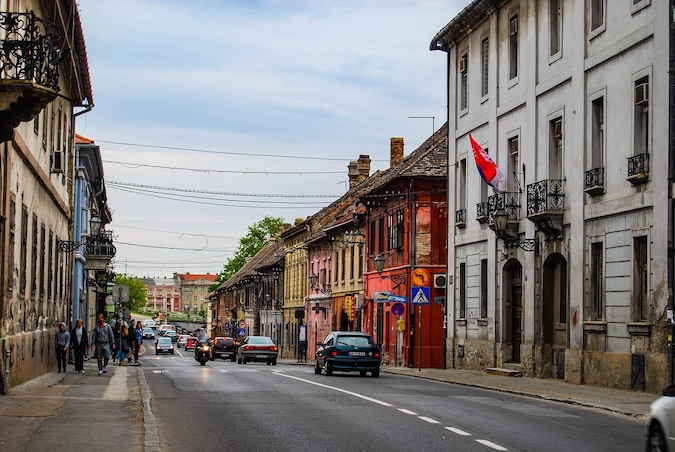Click on the map below to learn more
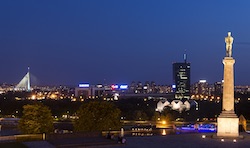 |
Belgrade, SerbiaBelgrade is the capital city of Serbia and is one of the oldest continuously inhabited cities in Europe. Located at the confluence of the Danube and Sava rivers, Belgrade has a rich history that has left its mark on the city's architecture, culture, and people. Belgrade has been inhabited since ancient times and has been conquered and ruled by many different empires and kingdoms over the centuries, including the Romans, Byzantines, Ottoman Turks, and Austro-Hungarians. This history has left a diverse mix of architectural styles in the city, from ancient Roman ruins to Ottoman mosques and Austro-Hungarian buildings. One of the most iconic landmarks of Belgrade is the Belgrade Fortress, which sits atop a hill overlooking the city and the rivers. The fortress was first built by the Romans in the 2nd century AD and has been expanded and modified by subsequent rulers over the centuries. Today, it is a popular destination for tourists and locals alike, offering stunning views of the city and the rivers. Another notable attraction in Belgrade is the Kalemegdan Park, which is located adjacent to the fortress. The park is one of the largest and most beautiful parks in the city and offers a peaceful escape from the hustle and bustle of the city streets. It is home to many historical monuments and has several walking trails and gardens for visitors to explore.
|
|
|
|
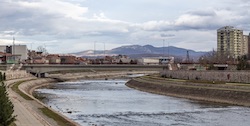 |
Nis, Serbia
Nis is the third-largest city in Serbia and one of the oldest continuously inhabited cities in Europe, with a history that dates back to the Roman Empire. Located in the southern part of the country, Nis is known for its rich history, cultural heritage, and stunning natural surroundings. One of the most iconic landmarks in Nis is the Nis Fortress, which was built in the 18th century on the site of an ancient Roman fortification. The fortress has played an important role in the city's history and was the site of many battles and sieges over the centuries. Today, it is a popular destination for tourists and locals alike, offering stunning views of the city and the surrounding countryside. Another notable attraction in Nis is the Skull Tower, which is a unique and macabre monument to a tragic event in Serbian history. The tower was built by the Ottomans in the early 19th century, using the skulls of Serbian rebels who had been killed in battle. Today, it is a sobering reminder of the sacrifices that were made in the struggle for Serbian independence. Nis is also famous for its vibrant and lively cultural scene, with a rich tradition of music, dance, and theater. The city hosts several cultural festivals throughout the year, including the Nisville Jazz Festival, which attracts jazz musicians from around the world, and the Nis Film Festival, which showcases the best in Serbian and international cinema. Food is also an important part of the culture in Niš, with a rich and diverse culinary scene that reflects the city's history and influences. Traditional Serbian cuisine is hearty and flavorful, with dishes such as pljeskavica (grilled meat patties), cevapi (grilled meat sausages), and gibanica (a savory pastry with cheese and spinach) being popular favorites. In addition to its cultural attractions, Nis is also known for its stunning natural surroundings. The city is situated at the foot of the Suva Planina mountain range, which offers excellent hiking and skiing opportunities, as well as breathtaking views of the surrounding countryside.
|
|
|
|
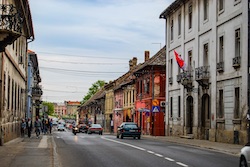 |
Novi Sad, SerbiaNovi Sad is the second-largest city in Serbia and the administrative center of the autonomous province of Vojvodina. Known as the "Athens of Serbia" for its rich cultural heritage, Novi Sad is a vibrant and cosmopolitan city that offers something for everyone. One of the most iconic landmarks in Novi Sad is the Petrovaradin Fortress, which was built in the 17th century on the banks of the Danube River. The fortress is an impressive feat of military engineering, with 16 kilometers of underground tunnels, numerous bastions and gates, and a clock tower that is one of the symbols of the city. Today, it hosts several cultural events and festivals, including the famous EXIT music festival, which attracts thousands of visitors from around the world every year. Another notable attraction in Novi Sad is the historic city center, which features a unique blend of architectural styles from different periods in history. The city's main square, Trg Slobode (Freedom Square), is a popular gathering place for locals and tourists alike, and is home to several historic buildings, including the 18th-century Catholic Church of the Name of Mary and the neo-Gothic City Hall. Novi Sad is also known for its vibrant cultural scene, with a rich tradition of music, theater, and art. The city is home to several museums and galleries, including the Museum of Vojvodina, which showcases the history and culture of the region, and the Gallery of Matica Srpska, which is one of the oldest and most prestigious art institutions in Serbia.
|
|
|
|
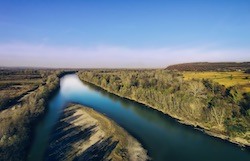 |
Morava River
The Morava River originates in the Krkonoše Mountains in the Czech Republic, where two small streams, the White and the Black Morava, converge. The river then flows eastward, passing through the city of Olomouc before entering Slovakia. In Slovakia, the river is known as the Morava River as well, and it flows through the towns of Komárno and Bratislava before entering Serbia. In Serbia, the river is known as the Great Morava and flows into the Danube River near the city of Smederevo. The Morava River basin covers an area of around 38,000 square kilometers, with the majority of the basin located in the Czech Republic. The river is an important source of water for the agricultural and industrial sectors in the regions it passes through, and it also supports various species of flora and fauna. The Morava River has played a significant role in the history and culture of the regions it traverses. The river has been a vital transport route since ancient times, facilitating trade and commerce between different regions. The river was also a natural barrier, protecting the regions it passed through from invading armies. The Morava River has been referenced in literature, poetry, and music, with many famous works inspired by its beauty and significance. The Morava River is also an important tourist destination, with many picturesque towns and villages located along its banks. Visitors can enjoy scenic boat rides along the river, visit historical landmarks such as castles and fortresses, and explore the rich cultural heritage of the regions it passes through. However, the Morava River is not without its challenges. The river is susceptible to flooding, and flood control measures have been implemented in various regions to protect against flood damage. Pollution is also a significant concern, as the river is heavily used for agricultural and industrial purposes. Efforts are being made to address these challenges, including the implementation of environmental protection measures and the promotion of sustainable practices in the regions surrounding the river. |
|
|
|
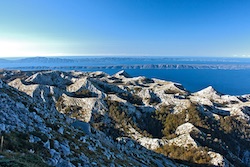 |
The Dinaric AlpsThe Dinaric Alps, also known as the Dinarides, is a mountain range that stretches across several countries in Southeast Europe. The range spans approximately 645 miles (1,038 kilometers) from the Julian Alps in northeastern Italy, through Slovenia, Croatia, Bosnia and Herzegovina, Serbia, Montenegro, and Albania, before ending in Kosovo. The Dinaric Alps are a natural wonder, home to unique flora and fauna and playing a significant role in the history and culture of the regions it traverses. The Dinaric Alps are the fifth most extensive mountain range in Europe, covering an area of around 100,000 square kilometers. The highest peak in the range is Mount Triglav in Slovenia, standing at 9,396 feet (2,864 meters) tall. The range is known for its rugged terrain, with steep cliffs, deep gorges, and karst topography. The karst landscape, formed by the dissolution of soluble rocks such as limestone, is a defining feature of the Dinaric Alps. The Dinaric Alps are home to a diverse range of flora and fauna, including many endemic species. The mountain range is an important habitat for several large carnivores, including brown bears, wolves, and lynx. The range is also home to several bird species, including the endangered Balkan lynx and the griffon vulture. The Dinaric Alps have played a significant role in the history and culture of the regions it traverses. The mountain range has served as a natural barrier, protecting the regions from invading armies throughout history. The rugged terrain and harsh weather conditions of the Dinaric Alps have also shaped the cultural traditions of the people who live in the region. The mountain range is home to several UNESCO World Heritage Sites, including the old town of Dubrovnik in Croatia and the historic city of Berat in Albania. The Dinaric Alps are also a popular destination for outdoor enthusiasts. The mountain range offers opportunities for hiking, rock climbing, and skiing, as well as wildlife watching and sightseeing. Visitors can explore the many national parks and nature reserves in the region, including Plitvice Lakes National Park in Croatia and Durmitor National Park in Montenegro. However, the Dinaric Alps face several challenges, including climate change, overgrazing, and deforestation. Climate change has resulted in the retreat of glaciers and changes in the vegetation patterns in the region. Overgrazing and deforestation have also resulted in soil erosion and the loss of biodiversity. Efforts are underway to address these challenges, including the implementation of sustainable land-use practices and the promotion of ecotourism. |
|
|
|
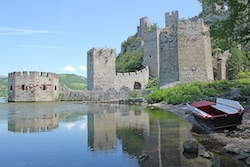 |
Danube RiverThe Danube River is one of the most famous rivers in the world, stretching for 2,860 kilometers (1,777 miles) and flowing through ten countries in Europe. It is the second-longest river in Europe, after the Volga, and serves as a vital lifeline for the countries it passes through. The Danube River has played a significant role in the history, economy, and culture of Europe and remains an important waterway today. The source of the Danube River is located in the Black Forest of Germany, and it flows through several countries, including Austria, Bulgaria, Croatia, Hungary, Romania, and Serbia before emptying into the Black Sea. The river also forms part of the border between Romania and Bulgaria, as well as between Croatia and Serbia. The Danube River has been an important transportation route since ancient times, and it has played a vital role in the history and economy of Europe. The river was a key trade route for the Roman Empire, and it was also an important factor in the Ottoman Empire's expansion into Europe. Today, the Danube River is a significant transportation route for goods and people, with many ports and cities located along its banks. The Danube River is also home to a rich and diverse ecosystem, with many unique and endangered species found along its banks. The river is an important habitat for fish, birds, and other wildlife, and it provides essential resources for the surrounding communities. The river also supports a thriving tourism industry, with visitors from around the world coming to explore the many cultural and natural attractions along its banks. The Danube River has played a significant role in shaping the culture and history of Europe, and it remains an important symbol of the continent's shared heritage. The river has inspired countless artists, writers, and musicians, and it has been the subject of many works of art and literature throughout history. The Danube River is also an important site for cultural festivals and events, with many cities along its banks hosting celebrations and performances throughout the year. Despite its importance, the Danube River faces many challenges today, including pollution, overfishing, and habitat loss. Many organizations are working to address these issues and protect the river's unique ecosystem, including the International Commission for the Protection of the Danube River (ICPDR) and the Danube River Basin Management Plan. These efforts are crucial in ensuring the long-term health and sustainability of the river and its surrounding communities.
|
|
|
|
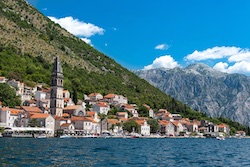 |
The Balkan MountainsThe Balkan Mountains, also known as the Stara Planina, is a range of mountains that stretches across much of the Balkan Peninsula in southeastern Europe. The range runs through several countries, including Bulgaria, Serbia, and Romania, and is a defining feature of the region's landscape and culture. The Balkan Mountains have played an important role in the history and development of the Balkans. The range has served as a natural barrier, separating different regions and kingdoms throughout history. It has also been a source of valuable natural resources, including timber, minerals, and fertile soil. The Balkan Mountains are home to a rich and diverse array of wildlife, including several species that are found nowhere else in the world. The range is a vital habitat for many endangered and threatened species, including the Balkan lynx, the Balkan chamois, and the brown bear. The Balkan Mountains are also a popular destination for hikers, skiers, and other outdoor enthusiasts. The range offers a stunning array of scenery, with snow-capped peaks, dense forests, and rushing rivers. Many of the region's small towns and villages are located in the foothills of the mountains and offer a glimpse into the region's traditional way of life. Despite their importance, the Balkan Mountains face several threats, including deforestation, overgrazing, and pollution. Many organizations are working to address these issues and protect the range's unique ecosystem. These efforts include reforestation programs, conservation initiatives, and public awareness campaigns aimed at promoting sustainable practices and protecting the range's natural heritage. The Balkan Mountains are also an important cultural symbol for the region, and they have inspired countless artists, writers, and musicians throughout history. The range has been the subject of many works of literature and art, and it has played a significant role in shaping the region's cultural identity. |
Belgrade |
|
| Population: | 6,940,000 (2021) |
| Area: | 29,922 sq. miles |
| Capital City: | Belgrade |
| Largest City: | Belgrade |
| Currency: | Serbian dinar |
| Official Language: | Serbian |
| GDP (Gross Domestic Product) | $49.3 Billion (86th) |
| Back to Map | |
Novi Sad, Serbia
|
|
|
|
 |
|
The Serbian flag is a symbol of the country's rich history and culture, and it holds a special place in the hearts of the Serbian people. The flag consists of three horizontal stripes, with the top and bottom stripes being white and the middle stripe being a deep shade of red. The origins of the Serbian flag can be traced back to the medieval period, when the country was ruled by the Nemanjic dynasty. The red and white colors are said to have been chosen by the founder of the dynasty, Stefan Nemanja, who used them as a symbol of his family's power and authority. Over the centuries, the Serbian flag has undergone several changes and modifications. In the early 19th century, the flag was updated to include a coat of arms in the center, which featured a two-headed eagle and a cross. This version of the flag was used until the end of World War I, when Serbia became part of the Kingdom of Yugoslavia. During the communist era, the flag was modified again to reflect the country's new political ideology. The coat of arms was removed, and a red star was added to the center of the flag. This version of the flag was used until 1992, when Serbia regained its independence following the breakup of Yugoslavia. Today, the current version of the Serbian flag is a reflection of the country's long and complex history. The red color represents the blood of Serbian martyrs and heroes, while the white color represents purity, honesty, and peace. Together, these colors embody the resilience and strength of the Serbian people, who have faced many challenges throughout their history. Back to Map |
|
